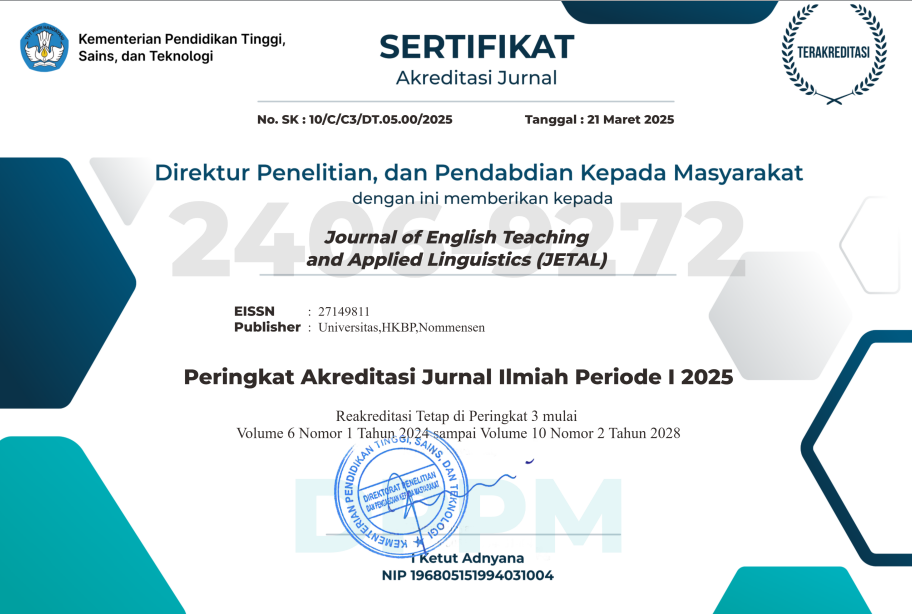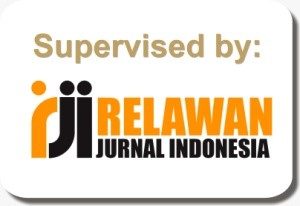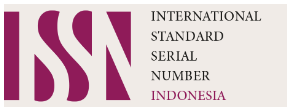THE EIGHTH GRADERS’ PERCEPTION ON SPEAKING ONLINE LEARNING DURING COVID-19 PANDEMIC IN SMP IT MISYKAT AL-ANWAR
Abstract
This research examines how students perceive online English learning as well as the advantages and disadvantages of online learning during the Covid 19 pandemic. Moreover, speaking skills require a lot of practice so that students are fluent in English. However, with the Covid-19 pandemic, all learning activities are carried out online. The problem of this research is how the students perceive online English learning and its advantages and disadvantages. The researchers used qualitative methods. Result of this research shows that learning to speak online through media such as Google Classroom, Google Meet, and Zoom makes students enjoy learning more because the material can be accessed from anywhere without having to come to school. The disadvantages are, that many students experienced material that was not conveyed, felt monotonous, and also that the network signal was inadequate for smooth learning.
References
Anuradha, R. V., Raman, G., & Hemamalini, H. C. (2014). Methods of teaching English. Hyderabad: Neelkamal Publications.
Ari, N.W. (2020). The Effect of Google Classroom on Students’ Reading Comprehension in Narrative Text and Their Learning Motivation (Pre Experimental Study at Smk Muhammadiyah Kradenan) (Doctoral Dissertation, UNIMUS).
Arifa. (2020). Kendala sinyal yang kurang baik terhadap hasil belajar yang optimal dimasa pandemi di sd negeri 1 wunggoloko.
Asrul, N. A. M. (2020). Ekspektasi Dan Tingkat Kepuasan Mahasiswa Jurusan Keperawatan Uin Alauddin Makassar Terhadap Kualitas Layanan Pendidikan Secara Daring Selama Pandemi Covid 19. Jurnal Administrasi Publik, 16(2), 111-122.
Bute, A. M. O. L. (2020). Google Classroom: A Subtitute to Classroom Teaching in Engineering Colleges. Research Journal of English Language and Literature (RJELAL), 8(2), 240-244.
Campbell, N. A., Reecee, J. B., & Mitchell, L. G. (2002). Biologi Jilid 1 (A. Safitri, L. Simarmata, & H. W. Hardani (Eds.); 5th ed.). Erlangga.
Daryanto. (2013). Media Pembelajaran: peranannya sangat penting dalam mencapai tujuan pembelajaran (Cetakan 1,). Gava Media.
E.Gray, D. (2004). Peningkatan Kemampuan Speaking Melalui Model “Triple P.” 32–43.
Fajri, K., Sumiadi, S., Sunendar, D., & Iskandarwassid, I. (2020, March). Character Education Behind the Function and Value of Cirebonan Tarling Art. In International Conference on Elementary Education (Vol. 2, No. 1, pp. 395-401).
Fatonia, N. A., Nurkhayatic, E., Nurdiawatid, E., Fidziahe, G. P., Adhag, S., Irawanh, A. P., ... & Azizik, E. (2020). University students online learning system during Covid-19 pandemic: Advantages, constraints and solutions. Systematic reviews in pharmacy, 11(7), 570-576.
Fowler, R., Hodge, B., Kress, G., & Trew, T. (2018). Language and control. Routledge.
Harmer, J. (2007). How to Teach English. ELT Journal, 62(3), 313–316.
Hidayat, N., & Nuraida, N. (2022). Pendampingan Asuhan Keperawatan Medikal Bedah pada Pasien dengan Gangguan Sistem Persyarafan: Fraktur Lumbal. Kolaborasi Jurnal Pengabdian Masyarakat, 2(3), 226-237.
Hussain, S. (2017). Teaching Speaking Skills in Communication Classroom. International Journal of Media, Journalism and Mass Communications, 3(3), 14–21. https://doi.org/10.20431/2454-9479.0303003
Irawan, R. (2022). Persepsi Siswa Dalam Pembelajaran Bahasa Inggris Secara Daring Menggunakan Platform Google. Equilibrium: Jurnal Pendidikan, 10(3), 374-379.
Jannah, M. (2021). Mengetahui Persepsi Siswa terhadap Penggunaan Aplikasi Video Conferencing untuk Pembelajaran Bahasa Inggris di tengah Pandemi Covid-19 (Doctoral dissertation, Universitas Brawijaya).
Jyothsna, S., Manjula, G., Rao, P. C., Sammaiah, D., & Rao, A. N. (2021). Estimation of trace elemental concentration in Azadirachta indica and Withania somnifera anti-cancer medicinal plants of Telangana using EDXRF technique. Materials Today: Proceedings, 43, 2383-2388.
Kemp, C. (2007). Strategic processing in grammar learning: Do multilinguals use more strategies?. International Journal of Multilingualism, 4(4), 241-261.
Maryuliana, Subroto, I. M. I., & Haviana, S. F. C. (2016). Sistem Informasi Angket Pengukuran Skala Kebutuhan Materi Pembelajaran Tambahan Sebagai Pendukung Pengambilan Keputusan Di Sekolah Menengah Atas Menggunakan Skala Likert. Jurnal Transistor Elektro Dan Informatika, 1(2), 1–12.
Mualim, M., Ma’rufah, D. W., & Sartika, E. (2019, December). The Strengths and Pitfalls of Google Classroom Application to Gen-Z Students’ Learning Hybridity. In Proceeding International Conference on Islamic Education (ICIED) (Vol. 4, No. 1, pp. 297-301).
Mufliharsi, R., & Candra, E. N. (2018). Pembelajaran Berbicara Interaktif Bahasa Inggris di SMP Universitas Indraprasta PGRI Jakarta. 2(2), 35–40.
Nabila Tri Ambarwati, S. (2022). Synchronous Teaching Classes During the COVID-19 Pandemic: A Narrative Study of Indonesian Science Teacher’s Experience. Journal of Positive School Psychology, 8792-8804.
Needs, E. C. (2017). Chapter Five Teacher Authenticity And Emergent Classroom Needs: The Case Of Efl In Iran Amir Hossein Sarkeshikian. Authenticity in Materials Development for Language Learning, 84.
Olivia, S., Gibson, J., & Nasrudin, R. A. (2020). Indonesia in the Time of Covid-19. Bulletin of Indonesian economic studies, 56(2), 143-174.
Renandya, W. A., & Richards, J. C. (2022). Methodology in Language Teaching An Anthology of Current Practice. May. https://doi.org/10.13140/RG.2.2.36344.72962
Riyanto, S., Setiyadi, A. B., & Kadaryanto, B. (2015). The role of attitude to language learning in reading comprehension (Doctoral dissertation, Lampung University).
Rizqi, P. P. A. D. (2020). An Analysis of English Teaching Activities in Pandemic Era at SMP N 1 Doplang. 1–17.
Rosenberg, M. J. (2001). E-learning: Strategies for Delivering Knowledge in the Digital. Mcgraw-2001.
Sanderson, P. E. (1999). E-Learning: strategies for delivering knowledge in the digital age. Patient Care, 33(5), 197–211.
Setiani, F., Al Fath, M. S., Putri, N. S. E., Sistiarini, R. D., Saputra, A., Hidayati, H., & Fatchurahman, M. (2020, October). Shift-learning: Suburban Teachers’ Perspectives Towards Readiness and Media Learning Application During Pandemic Period. In The 5th Progressive and Fun Education International Conference (PFEIC 2020) (pp. 54-64). Atlantis Press.
Sibuea, T. F. B. (2018). Students’ Perceptions on the Use of Google Classroom To Support Blended Learning for the Pengantar Linguistik Umum Course. Lingua : Jurnal Ilmiah, 14(2), 49–63. https://doi.org/10.35962/lingua.v14i2.45
Sofiana, N. (2015). Implementasi blended learning pada mata kuliah extensive listening. Tarbawi: Jurnal Pendidikan Islam, 12(1).
Sugiyono. (2015). Metode Penelitian Pendidikan Pendekatan Kuantitatif, Kualitatif, dan R&D (Cet. 21). Alfabeta.
Sugiyono. 2016. Metode Penelitian Pendidikan Pendekatan kuantitatif, Kualitatif, dan R&D. Bandung: Alfabeta
Suputra, P. E. D., Nitiasih, P. K., & Paramarta, I. M. S. (2020). Kelas Daring Bahasa Inggris Di Masa Pandemi : Sebuah Tantangan Pembelajaran. Seminar Nasional Riset Inovatif, 7, 110–118.
Suyanto, S. (2005). Konsep Dasar Anak Usia Dini. Departemen Pendidikan Nasional.
Torky, Shiamaa abd E. F. (2014). The Effectiveness of a Task- Based Instruction program in Developing the English Language Speaking Skills of Secondary Stage Students A thesis Supervised by. Ain Shams University Women’s College Curricula and Methods of Teaching Departement, 1–254. https://doi.org/10.1200/JCO.2005.05.4296
Tuti, F. M., Musriandi Riki, & Suryani L. (2020). Covid-19 : Penerapan Pembelajaran Daring Di Perguruan Tinggi. Dedikasi Pendidikan, 4(2), 193–200.
Wajdi, M. B. N., Kuswandi, I., Al Faruq, U., Zulhijra, Z., Khairudin, K., & Khoiriyah, K. (2020). Education policy overcome coronavirus, a study of Indonesians. EDUTEC: Journal of Education And Technology, 3(2), 96-106.
Yamaguchi, Y., Koga, M., Sato, S., Yamagami, H., Todo, K., Okuda, S., (2018) Study Investigators. Early achievement of blood pressure lowering and hematoma growth in acute intracerebral hemorrhage: Stroke acute management with urgent risk-factor assessment and improvement-intracerebral hemorrhage study. Cerebrovascular Diseases, 46(3-4), 116-122.

This work is licensed under a Creative Commons Attribution-ShareAlike 4.0 International License.
Authors retain copyright and grant the journal right of first publication with the work simultaneously licensed under a Creative Commons Attribution-ShareAlike 4.0 International License (CC BY-SA 4.0) that allows others to share the work with an acknowledgment of the work's authorship and initial publication in this journal.
Authors are able to enter into separate, additional contractual arrangements for the non-exclusive distribution of the journal's published version of the work (e.g., post it to an institutional repository or publish it in a book), with an acknowledgment of its initial publication in this journal.
Authors are permitted and encouraged to post their work online (e.g., in institutional repositories or on their website) prior to and during the submission process, as it can lead to productive exchanges, as well as earlier and greater citation of published work (See The Effect of Open Access).






